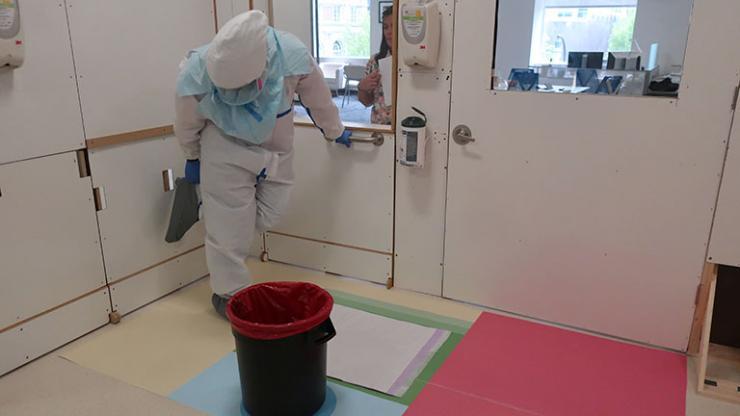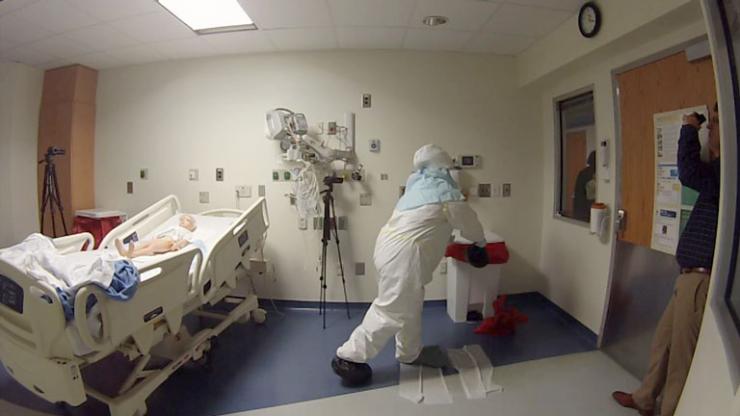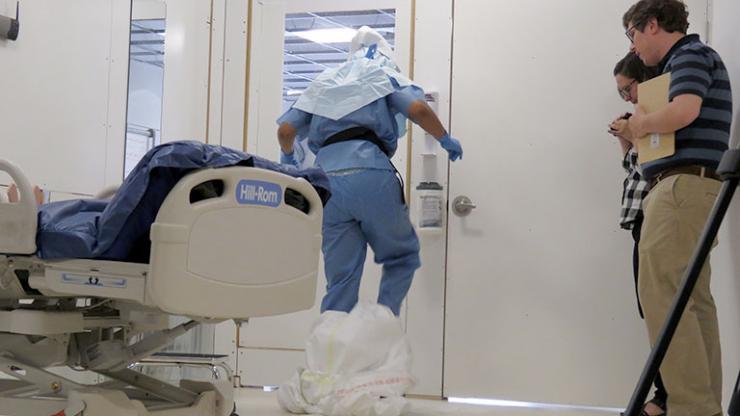SimTigrate’s Research Benefitting 2 Atlanta Hospitals to Appear in Special Clinical Disease Supplement
Oct 03, 2019 — Atlanta, GA

These doffing simulations use a rapid cycle improvement approach.
The SimTigrate Design Lab has developed a valuable expertise – and provided real-world use in Atlanta -- in the design of biocontainment units such as those designed to treat patients with Ebola. The results of the lab's research is included in a special supplement from the CDC’s Prevention Epicenters Program.
On October 1, the CDC Prevention Epicenters Program released the print version: Personal Protective Equipment for Preventing Contact Transmission of Pathogens: Innovations from the CDC Prevention Epicenters Program, a supplement to Clinical Infectious Diseases. The digital version was released in September.
The publication includes 14 in-depth studies, including three co-authored by SimTigrate researchers. It provides insights from recent work to improve routine use of personal protective equipment (PPE) and Ebola-specific PPE, and prevent contact transmission of pathogens to better protect patients and healthcare professionals (HCPs).
Key findings from the supplement include:
- Healthcare providers (HCP) are frequently contaminated with pathogens during routine patient care.
- Personal Protective Equipment (PPE) is an important component for preventing this contamination, but optimal use of PPE is difficult.
- Self-contamination can occur, especially when PPE is removed, potentially endangering HCP and patients.
- HCP contamination can be minimized with HCP training, careful design of the doffing space, improving PPE design and facilitating appropriate PPE use.
SimTigrate’s Research Spans Years
Under the leadership of Professor Craig Zimring, SimTigrate has been engaged in research and investigation on the design of biocontainment units for several years from both the perspective of the healthcare worker safety and the patient experience. The team interviewed all 4 patients who were treated for Ebola at Emory in 2014 to understand their experience as patients.
SimTigrate as part of Georgia Tech and the College of Design, together with Emory University and Georgia State University, was involved in the (PEACH) research program that was funded by the CDC - Prevention Epicenter of Emory and Atlanta Consortium Hospitals (PEACH) research program.
Jennifer DuBose, associate director of SimTigrate Design Lab, expressed pleasure at seeing the results of the Lab’s work in practice.
“It is really gratifying to see the work that we have done move from theory to practice. With the publication of our research it is possible that many hospitals will benefit, but it is particularly satisfying to know that we have improved the design of two hospitals in our backyard,” she said.
Children’s Healthcare of Atlanta is one of the hospitals the lab is working with, helping them evaluate and refine the design of their doffing space in the 6 biocontainment rooms that will go into their new bed tower.
The new Children’s Healthcare of Atlanta Hospital, at the corner of I-285 and North Druid Hills Road, includes two patient towers. The completion of the hospital support building is planned for early 2020, while the hospital at North Druid Hills will begin serving patients in 2025.
Ph.D. Student Leading Children's Healthcare Research
Zorana Matić, a Ph.D. student who is leading the current research effort, said Children’s Healthcare of Atlanta Special Care Unit (CHOA SCU) will be used for the treatment of pediatric patients with lethal, contagious diseases.
This unit will be set up to treat children with highly infectious diseases such as severe acute respiratory syndrome (SARS), smallpox, tularemia, plague, viral hemorrhagic fevers (such as Ebola), and drug-resistant illnesses.
DuBose is the PI (Principal Investigator) on the Children’s Healthcare project. The team also includes two graduate students, Benton Humphreys, a master’s student in Human-Computer Interaction (HCI), and Alexandra Nguyen, also a masters student in HCI (Psychology & Human Factors).
Student involvement is a central element of SimTigrate’s approach to research; the primary author of one of the papers in the supplement was Maria Wong Sala who graduated from Georgia Tech a master’s in Human Computer Interaction this past spring.
Matić described the past work that SimTigrate did on biocontainment units, which led to them being sought out for involvement with CHOA.
“SimTigrate researchers evaluated the four Ebola treatment facilities in Georgia, and built a high-fidelity mock-up of a biocontainment unit (BCU), in which we tested different design solutions. We analyzed the interactions between healthcare workers (HCWs) and the built environment in the four different settings and identified instances where the built environment failed to support safe HCW’s behavior while doffing,” she said.
Building on the knowledge gained through these specific projects and the lab’s body of evidence-based design research, they are helping CHOA create at a world-class design for the 6 new biocontainment rooms where the environment will support safe doffing of PPE for the healthcare workers.
SimTigrate attended and observed CHOA simulations at a full-size hospital mock-up, evaluated the proposed designs, analyzed alternatives, and proposed specific solutions for designing a facility and care process that would deliver an exceptional experience for patients, their families, and the healthcare team, Matić said.
The redesigned doffing space aims to improve the safety of the staff and reduce risk of self- and cross-contamination and occupational injury. It also is expected to reduce the physical effort and cognitive load of healthcare workers, she said.
Emory University Hospital Midtown to Get Biocontainment Room
The other major medical facility getting help from SimTigrate is Emory University Hospital Midtown (EUHM).
SimTigrate Design Lab is involved in evaluating the proposed designs, analyzing alternatives, and proposing specific solutions for designing the EUHM Mother-Baby Infectious Disease Suite.
DuBose said they are helping the facility optimize the unit design to increase the safety of the healthcare personnel who provide patient care and to improve the patient’s experience.
The hospital currently does not have mother-baby biocontainment rooms, but DuBose said the biocontainment unit will be the first mother-baby Infectious Disease Suite, that they are aware of, anywhere.
It will retrofit existing space to establish the mother-baby Infectious Disease Suite with unidirectional flow, a dedicated donning area, an anteroom for monitoring and observation, and a dedicated doffing area outside the treatment room.
The treatment room will have full-size windows, enabling unobstructed monitoring of the patient. Adjacent to the treatment room is the exam room that will be used for accommodating PUI (Person Under Investigation) and/or newborn.
DuBose said the mother-baby Infectious Disease Suite will be used to assess pregnant women with suspected seriously communicable diseases and deliver the babies.
Besides donning and doffing of Personal Protective Equipment in highly infectious environments, SimTigrate also looked at the thoroughness of hand hygiene while donning and doffing.
You can read more about SimTigrate’s research in the supplement.
Pages S214-S220: Common Behaviors and Faults when Doffing Personal Protective Equipment for Patients with Serious Communicable Diseases
Pages S221-S223: Variability in Duration and Thoroughness of Hand Hygiene in Biocontainment units
Pages S241-S247: Design Strategies for Biocontainment Units to Reduce Risk During Doffing of High-Level Personal Protective Equipment

Researchers observe simulations in one of the four state-designated Ebola treatment centers in Georgia.

A researcher observes a doffing simulation in a mock-up of a biocontainment unit.

Jennifer DuBose is a senior research associate at Georgia Tech’s College of Architecture.

Zorana Matic
Malrey Head
Digital Communications Specialist
College of Design




